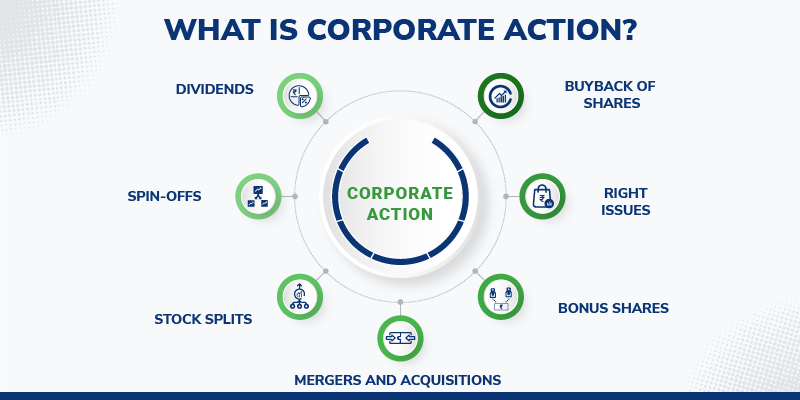

In this review, we will discuss all types of corporate actions with examples without any pdf files or additional guides and provide the latest information about each one. But let’s start with the basics.

What is a corporate action?
Corporate actions are events that occur in a company’s life that affect its shareholders. They can include issuing new shares, declaring a dividend, or undergoing a merger or acquisition. Each corporate action is an essential source of insight into a company’s financial health and short-term future.
Examples of corporate actions
Corporate actions include stock and reverse splits, dividends, mergers and acquisitions, rights issues, and spin-offs. These critical decisions usually do not take place without the approval of the company’s board of directors and shareholders.
To make the best decision for your investment portfolio, you must be aware of upcoming and latest corporate actions. You can find information in the news and on the company’s website.
Main types of corporate actions
There are two main types of corporate actions: mandatory and voluntary. Mandatory action is initiated by the company’s board of directors, while voluntary action occurs when shareholders decide to participate in the action.
In the first case, the reaction of shareholders is not important. Examples of mandatory actions include events such as mergers and stock splits.
In the second case, the company cannot act without shareholders’ reaction. Examples of voluntary corporate actions include rights issues and open offers.
All types of corporate action have different implications for shareholders. For instance, a stock split usually results in shareholders owning more shares with a lower per-share value, while a merger could see two companies combining their operations and assets. It’s important to understand the potential impacts of each type of event before taking any action.
The stock split
One of the most common types of corporate actions is the stock split. This happens when a company’s board of directors decides to increase the number of outstanding shares by dividing each share into multiple pieces. For example, if a company does a two-for-one stock split, every shareholder will end up with twice as many shares as they had before.
Stock splits can be either mandatory or voluntary, but they are usually done voluntarily to make shares more affordable and increase liquidity.

The reverse split
This mandatory event occurs when a company’s stock price falls below a certain level. To boost its share price, the company will reduce the number of outstanding shares by consolidating them into fewer, more valuable ones. For example, if a company has 100 million shares outstanding and completes a reverse split, it would have just 50 million shares outstanding.
While this may sound like bad news for shareholders, it’s not necessarily so. The main reason is that the share price will usually increase after a reverse split since fewer shares are now available on the market. It can lead to an increase in the value of your investment.
However, there can be downsides too. For example, a reverse split may help a company’s share price recover in the short term, but it can also signal to investors that the company is in trouble and may not be a good long-term investment.
Dividends
Another common type of corporate action is a dividend. A dividend is a distribution of a company’s earnings to shareholders, which can be either cash or shares of stock. Dividends are typically paid out quarterly but can also be paid annually or on an as-needed basis.
Cash dividends are the most common type of dividend, and they are paid out of a company’s earnings. For example, if a company earned $100 million last year, it might declare a cash dividend of $0.50 per share. That means each shareholder would receive 50 cents for every share they own.
On the other hand, share dividends are paid in stock shares rather than cash. So, if a company has 100 million shares outstanding and it declares a share dividend of 20%, each shareholder would receive 20 additional shares.
Spin-off
A spin-off is a type of corporate action in which a company splits off a portion of its business to form a new, independent company. Spin-offs are often undertaken to unlock value for shareholders or to focus the parent company on its core operations. They can also be used as tax planning strategies.
Spin-offs can be either partial or complete. The parent company retains a controlling interest in the new company in a partial spin-off. This type of spin-off is often used to allow shareholders to invest in a specific part of the business without selling their shares in the parent company. On the other hand, a complete spin-off results in the complete separation of the two companies.
Shareholders typically receive shares in the new company in a spin-off. They may also be allowed to exchange their shares in the parent company for shares in the new company. The terms of each spin-off are unique and will be determined by the board of directors of the parent company.
Note! A corporate action such as a spin-off usually occurs at a mature stage in a company’s life cycle.
Rights Issues
The rights issue takes place in the form of a stock split. It entitles existing shareholders to buy or receive additional or new company shares before their public offering. This corporate action is an excellent opportunity for shareholders to take advantage of a promising new development.
Mergers and Acquisitions
Mergers and acquisitions are when two companies merge into one. Shareholders of both companies usually receive shares in the new company, although the exact terms may vary depending on the deal.
Mergers and acquisitions can be friendly or hostile. In the first case, both companies agree to the deal, and shareholders vote in favor of it.
A hostile merger is when one company tries to take over another without the approval of its shareholders. It can often lead to a long and drawn-out battle between the two companies, with shareholders getting caught in the middle.
The bottom line
The risks associated with corporate actions can be significant, so you must understand what they are and how they work.
Corporate actions can significantly impact the value of your investment, so it’s essential to stay up to date on all upcoming events. If necessary, it is worth consulting with a financial advisor, weighing the potential risks and benefits.








